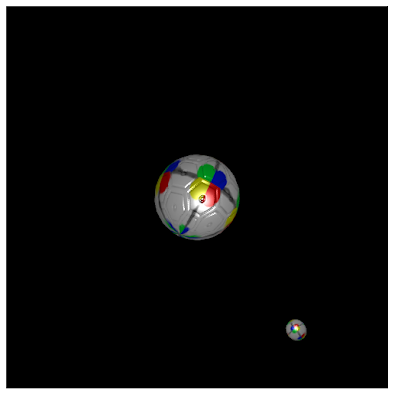I thought that I had figured out rotation and revolution in Gladius / CubicVR.js, but a comment from Alan Kligman, one of the Gladius maintainer, makes me think I may be mistaken.
Specifically, he indicates that revolution of the "moon" in my simulation is not tied to a global center of reference. Rather, it seems that the following code ties the moon (named "light-marker") to another object responsible for revolving:
space.findNamed( "light-marker" ).setParent( space.findNamed( "light-center" ) );When this "light-center" rotates, the light market (and any other objects with "light-center" as the parent) rotate with it.
At least that is what I think Alan means.
So I simplify the remnants of the Gladius example to:
space.add( new engine.simulation.Entity( "camera", /* ... */ ));
space.add( new engine.simulation.Entity( "moon", /* ... */ ));
var planet = new engine.simulation.Entity( "planet", /* ... */ );
space.add( planet );
var task = new engine.FunctionTask( function() {
// rotate planet
// rotate moon
}, {
tags: ["@update"]
});
In other words, this is how I had expected things to work yesterday before I convinced myself that Gladius / CubicVR.js worked otherwise.
I am much happier with this way of thinking. It is much easier to move individual objects without having to sync to a single frame of reference. But now that I have removed my previous parent object, the question becomes how can I make my moon more moon-like—without resorting to a light-center?
Now that I understand the dual-purpose of the light center, I think it makes a certain amount of sense. Instead of calling a light center, I relabel it a center of mass:
space.add( new engine.simulation.Entity( "moon-center-of-mass",
[
new engine.core.Transform( [0, 0, 5], [engine.math.TAU, engine.math.TAU, engine.math.TAU] )
]
));space.findNamed( "moon" ).setParent( space.findNamed( "moon-center-of-mass" ) );And, instead of rotating the moon, I rotate the center of mass:
var lightRotation = new engine.math.Vector3( space.findNamed( "moon-center-of-mass" ).findComponent( "Transform" ).rotation );
lightRotation = engine.math.vector3.add( lightRotation, [0, 0, space.clock.delta * 0.001] );
space.findNamed( "moon-center-of-mass" ).findComponent( "Transform" ).setRotation( lightRotation );
Much thanks to Alan for preventing me from laboring under a false assumption. Much better to correct that now than later when I had built much more understanding on faulty foundations.
Day #421
No comments:
Post a Comment